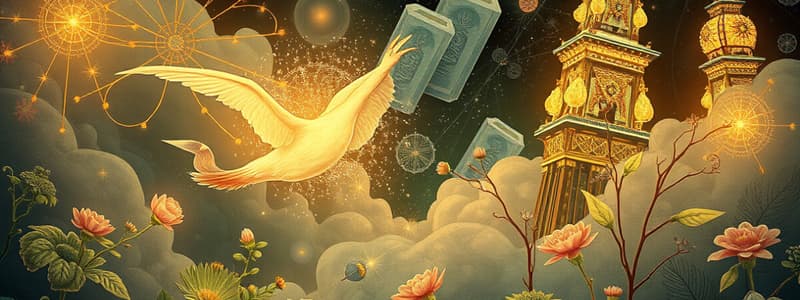Podcast
Questions and Answers
Which of the following is not a state of matter?
Which of the following is not a state of matter?
- Gas
- Energy (correct)
- Solid
- Liquid
What is one property of light?
What is one property of light?
- It travels in straight lines. (correct)
- It is always visible to the naked eye.
- It can only travel through water.
- It cannot be reflected.
Which layer of the Earth is solid and made mostly of rock?
Which layer of the Earth is solid and made mostly of rock?
- Crust (correct)
- Mantle
- Outer core
- Inner core
What part of a plant is primarily responsible for photosynthesis?
What part of a plant is primarily responsible for photosynthesis?
Which of these materials is most likely to become a gas when heated?
Which of these materials is most likely to become a gas when heated?
Study Notes
States of Matter
- Matter exists in three primary states: solid, liquid, and gas.
- Solids have a definite shape and volume, with particles closely packed together.
- Liquids have a definite volume but take the shape of their container, with particles close but able to move freely.
- Gases have no definite shape or volume and fill the entire space available, with particles far apart and moving rapidly.
- Matter can change from one state to another through processes such as melting, freezing, evaporation, condensation, and sublimation.
Basics of Light
- Light is a form of energy that travels in waves and can be seen by the human eye.
- It travels at a speed of approximately 299,792 kilometers per second (186,282 miles per second) in a vacuum.
- Light can be reflected, refracted (bent), and absorbed by different materials.
- Most objects are visible because they reflect light; for instance, a red apple appears red because it reflects red wavelengths of light.
- Light can travel through empty space without needing a medium, unlike sound, which requires air or another substance.
The Earth
- Earth is the third planet from the Sun in our solar system.
- It is the only planet known to support life, with a diverse range of ecosystems.
- Earth has four main layers: the crust, mantle, outer core, and inner core, each with different properties and temperatures.
- The Earth's surface is 71% water and 29% land, with oceans covering the majority of the planet.
- The planet rotates on its axis, which causes day and night, and it orbits the Sun, resulting in the changing seasons.
Plants
- Plants are living organisms that belong to the kingdom Plantae and are crucial for life on Earth.
- They perform photosynthesis, a process that converts sunlight, carbon dioxide, and water into glucose and oxygen.
- Key parts of a plant include roots (absorb water and nutrients), stems (support and transport), and leaves (main site of photosynthesis).
- Plants can be categorized into different types such as flowering plants (angiosperms) and non-flowering plants (gymnosperms).
- They provide oxygen, food, habitat, and contribute to the planet's ecosystem stability.
Studying That Suits You
Use AI to generate personalized quizzes and flashcards to suit your learning preferences.
Description
This quiz is designed for Grade 5 students, focusing on easy questions about states of matter, the basics of light, and an introduction to Earth and plants. Test your knowledge and understanding of these fundamental science topics with fun and engaging questions tailored for young learners.




